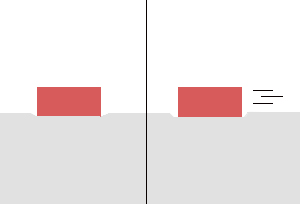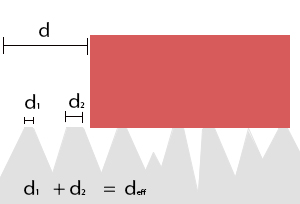Friction
This page describes several types of friction and explains how they affect systems.
The Main Idea
Friction is a force that resists movement between surfaces in contact. It is caused by the interactions between the molecules that make up objects. There are three types of friction: Static Friction, which resists motion between surfaces that are not moving with respect to each other; Kinetic Friction, which resists motion between surfaces that are moving with respect to each other; and fluid friction, which resists the motion of bodies moving through gases and liquids. When objects or substances touch, their surfaces of contact are not perfectly smooth on the molecular scale. The irregularities on these surfaces are ultimately responsible for all types of friction. All types of friction depend on the materials comprising the surfaces of the objects and substances involved, as well as on the normal force they exert on each other (that is, the force with which they are pressed together).
- Static Friction When two objects touch each other and there is no sliding between their surfaces of contact, they exert static friction forces on each other. The static friction force acting on each object opposes any force that would cause it to slide relative to the other object. For example, consider a heavy dresser at rest on the floor. If a child pushes against the side of the dresser in an attempt to slide it, that exerts a force on the dresser, but the ground would exert on it an equal and opposite static friction force that balances the force exerted by the child, so the dresser stays at rest. The static friction force can take on whatever direction and magnitude necessary to balance an external net force that threatens to cause sliding motion between two surfaces. However, the static friction force is limited by the maximum magnitude it can exert. If the external force becomes strong enough, the static friction force can be overcome and the surfaces can begin to slide, at which point the friction between the objects becomes kinetic. For example, now consider an adult pushing against the same heavy dresser. The adult can exert a stronger force than the child, and if it exceeds the maximum possible static friction force, the dresser can be set into motion and slid across the floor. Static friction is a result of the interlocking of rough surfaces. The protrusions on one surface settle into the grooves on the other when they are pressed together, and overcoming the interlocking requires a force strong enough to either break the protrusions or slide them past each other.
- Kinetic Friction When two objects touch each other and there is sliding between their surfaces of contact, they exert a kinetic friction force on each other. The kinetic friction force acting on each object acts in a direction opposite to its direction of motion relative to the other object. If the kinetic friction force is the only force acting on each object, they will eventually come to rest relative to each other, at which point the friction force between them becomes static. For example, consider a crate sliding across the floor. It will slow down and eventually come to rest due to the kinetic friction force between it and the floor, unless another force acts on it, such as the pushing of a person that wants to keep the crate moving. Kinetic friction force lowers the kinetic energy of a system, converting it to Thermal Energy. In other words, sliding between surfaces causes the surfaces to heat up. Usually in mechanical physics, this thermal energy is no longer considered part of the system and is considered lost because it usually dissipates into the environment without ever being converted back into mechanical energy. Kinetic friction is the result of abrasion between the protrusions of rough surfaces. The protrusions hit each other, sometimes causing them to break and always causing the molecules comprising them to wiggle. This increases the kinetic energy of the molecules at the sliding surfaces and reduces the kinetic energy of the macroscopic objects. This molecular energy is thermal energy.
- Fluid friction When an object moves through a liquid or gas, the fluid exerts a force on the object in the direction opposite to its motion relative to the fluid. Air Resistance is one common example of fluid friction that can affect the motion of projectiles and other objects in the earth's atmosphere. In many problems, you are asked to assume that the effects of air resistance are negligible because it is often not as strong as other forces and can significantly complicate math. However, the force exerted on an object by air resistance can be significant depending on the mass and geometry of the object, and the fluid friction exerted by thicker fluids such as water are almost always significant. Fluid friction, like kinetic friction, causes the conversion of energy from kinetic to thermal.
Often, friction is thought of as opposing all motion. In reality, it opposes the relative motion between objects or substances, which can in some situations actually cause motion. For example, consider a person who starts at rest and begins to walk. In order to walk, the person's foot must push off of the ground. In the absence of static friction, which is nearly the case on an ice skating rink, the shoe would slip across the ground without pushing off; it is only because static friction opposes the relative motion between the person's foot and the ground that they are able to begin moving. Similarly, consider a stationary object placed onto a moving conveyor belt. There would be kinetic friction between the object and the belt, causing the object to accelerate until it reaches the velocity of the belt. Finally, consider a river sweeping away a log that was initially at rest. The log was initially at rest relative to the riverbank, but relative to the running water, it was moving! Fluid friction is what opposed this relative motion, bringing the log to the velocity of the river water. In each of these examples, motion is caused by friction.
Note that static friction is present between rolling objects and the surface on which they roll. For more information, see the "rolling friction" section on the Static Friction page.
A Mathematical Model
These formulas give the magnitudes of each kind of friction.
- Static Friction As described above, the magnitude of the static friction force ([math]\displaystyle{ F_s }[/math]) between two objects is bounded by a maximum value. This maximum static friction force is given by [math]\displaystyle{ F_{s, max} = \mu_s * N }[/math] where [math]\displaystyle{ \mu_s }[/math] is the coefficient of static friction of the objects and [math]\displaystyle{ N }[/math] is the normal force between the objects. [math]\displaystyle{ \mu_s }[/math] is a property of the materials of the surfaces in contact and is usually less than 1.
- Kinetic Friction The magnitude of the kinetic friction force between objects is given by [math]\displaystyle{ F_k = \mu_k * N }[/math] where [math]\displaystyle{ \mu_k }[/math] is the coefficient of kinetic friction of the objects and [math]\displaystyle{ N }[/math] is the normal force between the objects. [math]\displaystyle{ \mu_k }[/math] is a property of the materials of the surfaces in contact and is usually less than 1. Note that this formula indicates that the magnitude of the kinetic friction force does not depend on the speed of the sliding between the objects. For any given pair of surfaces, their [math]\displaystyle{ \mu_s }[/math] value is greater than their [math]\displaystyle{ \mu_k }[/math] value.
- Fluid Friction The magnitude of the fluid friction force acting on an object moving through a fluid is given by [math]\displaystyle{ F_{fl} = b * v }[/math], where [math]\displaystyle{ b }[/math] is the drag coefficient and [math]\displaystyle{ v }[/math] is the speed of the object relative to the fluid. If an object is given an initial velocity [math]\displaystyle{ v_0 }[/math] through a fluid and fluid friction is the only force acting on it, the following differential equation can be derived from the formula above along with Newton's second law: [math]\displaystyle{ \frac{dv}{dt} = -bv }[/math]. This is a separable differential equation, and solving it yields [math]\displaystyle{ v = v_0 e^{-bt} }[/math], showing that the velocity of an object moving through a fluid exponentially decays if no other forces act on it. Another concept worth exploring regarding fluid friction is terminal velocity. See Terminal Velocity and Friction Due to Air. Note: in some scenarios, the magnitude of the fluid friction force acting on an object is more nearly proportional to the square of the object's velocity than to the object's velocity itself, but that model of fluid friction lies outside the scope of this page.
A Computational Model
This is a simulation of a box sliding along a surface. At first it experiences no friction, but when it passes the red line, it experiences a constant kinetic friction due to the floor until it comes to rest.
https://trinket.io/glowscript/76028c1809
Conceptualizing Friction
Why Friction Exists
It's important to understand why friction exists. Imagine a brick laying at rest on a table as seen below:
Now, if we take a look at the brick on a molecular level rather than a macroscopic scale, we can see that electron repulsion between the brick's molecules and the ground keeps the brick on the surface of the ground so that the brick doesn't simply "sink" into the ground. Electron repulsion one of the primary reasons why surfaces in contact interact with each other. Because however, there is a force due to gravity on the brick, the electrons in the ground also must exert a force on the brick to establish a net force of zero. This force from the electrons is created from the "spring-like" motion of the electrons on the brick when it begins to sink into the ground. The atoms in the ground will be squished together, and because electron repulsion grows stronger as electrons are closer, the atoms will repel each other and create a "spring-like" force on the brick. Once an equilibrium of forces is established, the molecular scale of the brick will look something like this:
Thus, when the brick is pushed forward, it will have to quite literally make the ground sink to make way for its motion. The force that the atoms in the path ahead exert on the brick is what we know as friction and accounts for the reason why friction is dependent on the normal force.
Understanding Work Done by Friction
As we know, the equation for work is as follows:
- [math]\displaystyle{ W = Fd }[/math] (for constant forces and one dimensional motion)
When friction is brought into the equation therefore, we get:
- [math]\displaystyle{ W = fd }[/math]
We therefore should theoretically be able to calculate the work done by friction. However, we can observe an anomaly when we take into account the change in internal energy. Imagine a block moving at a constant velocity. Since the velocity is constant, the net force should be zero. If only an applied force and friction acts on the block, then the forces are equal.
- [math]\displaystyle{ \Sigma {F} = 0 = {F}_{app} - f }[/math]
- [math]\displaystyle{ {F}_{app} = f }[/math]
This means that if we move an object a distance d, then the total energy change of the system is zero since the forces are equal and d is the same variable in both instances:
- [math]\displaystyle{ \Delta {E}_{sys} = 0 = {F}_{app} d - fd }[/math]
However, in a real world scenario, we observe that the temperature of the block increases as the block moves along the surface. According to our equations however, this cannot be possible since the net energy change is zero. The block moves at constant velocity which means that there is no kinetic energy change and no energy is transferred from outside the system. How is this possible? Looking at the block on a micro scale, it happens that the ground is actually not a perfect smooth surface. Instead, all surfaces have "teeth and gaps" that make it so that the block is not always in contact with the floor.
Applying this observation to our equations, the distance the apply force acts on the block stays the same; however, the distance that the frictonal force is applied on is drastically reduced. Therefore, our new equation for work (assuming constant forces) is:
- [math]\displaystyle{ \Delta {E}_{sys} = {F}_{app} d - f{d}_{eff} }[/math] where [math]\displaystyle{ {d}_{eff} \lt d }[/math]
Since kinetic energy remains constant, we can conclude that:
- [math]\displaystyle{ \Delta {E}_{sys} = \Delta {E}_{int} }[/math]
Now, our internal energy change is accounted for which shows why our temperature change exists.
Examples
Be sure to show all steps in your solution and include diagrams whenever possible
Simple
A 100Kg box is placed on a flat table. The box does not move. The coefficient of static friction [math]\displaystyle{ {μ}_{s} = {.25} }[/math] and the coefficient of kinetic friction [math]\displaystyle{ {μ}_{k} = {.15} }[/math]. Find the force of friction [math]\displaystyle{ {F}_{s} }[/math].
Solution:
Since the box does not move, there is only static friction. The normal force is equivalent to the force due to gravity: [math]\displaystyle{ {F}_{N} = {F}_{g} = {100}{g} }[/math]. The static friction can be found by: [math]\displaystyle{ {F}_{s} = {μ}_{s}{F}_{N} }[/math]
[math]\displaystyle{ {F}_{s} = {.25}*{100}*{9.8} = {245.25} }[/math]
Middling
A cart of mass 3Kg moves across a track pushed by a fan which exerts [math]\displaystyle{ {F} = \lt 3,0,1\gt }[/math]N with an initial velocity [math]\displaystyle{ {v}_{i} = \lt 1,0,1\gt \frac{{m}}{{s}} }[/math] . Find the required coefficient of kinetic friction [math]\displaystyle{ {μ}_{k} }[/math] needed to bring the cart to a stop in 10 seconds.
Solution:
Use the momentum principle: [math]\displaystyle{ {p}_{f} - {p}_{i} = {F}_{net}{dt} }[/math] and [math]\displaystyle{ {F}_{f} = {μ}_{k}{N} }[/math]
The final velocity must be 0. The initial velocity, initial force, and time are given.
[math]\displaystyle{ 0- \lt 3,0,3\gt = {F}_{net}*{10s} }[/math]
[math]\displaystyle{ {F}_{net} = \lt -0.3,0,-0.3\gt }[/math]
[math]\displaystyle{ {F}_{net} = {F} - {F}_{f} }[/math]
[math]\displaystyle{ \lt -0.3,0,-0.3\gt = \lt 3,0,1\gt - {F}_{f} }[/math]
[math]\displaystyle{ {F}_{f} = \lt 3.3,0,1.3\gt }[/math]
[math]\displaystyle{ {F}_{f} = \lt 3.3,0,1.3\gt = {μ}_{k}{N} }[/math]
[math]\displaystyle{ {N} = {3Kg} * {\lt 0,9.8,0\gt } = \lt 0,29.43,0\gt }[/math]
[math]\displaystyle{ {μ}_{k} = \frac{{F}_{f}}{{N}} = \frac{{\lt 3.3,0,1.3\gt }}{{0,29.43,0}} }[/math]
Difficult
Two blocks are stacked on top of one another on a frictionless surface. Block A is stacked on top of Block B. Block A has a mass of 2 Kg while Block B has a mass of 4 Kg. The coefficient of friction between the blocks is [math]\displaystyle{ {μ}_{s} = .35 }[/math]. Find the maximum amount of force that can be applied to Block A so that the blocks stay together.
Solution:
Momentum Principle:
[math]\displaystyle{ {p}_{f} - {p}_{i} = {F}_{net}{dt} }[/math]
We need to find the force of friction at its maximum to find the maximum amount of force that can be exerted on Block A. [math]\displaystyle{ {F}_{f} = {μ}_{s}{N} }[/math]
Forces on Block A:
[math]\displaystyle{ {F}_{A} - {F}_{f} }[/math]
Forces on Block B:
[math]\displaystyle{ {F}_{f} }[/math]
Since we want the blocks to move together, they must therefore have the same acceleration.
[math]\displaystyle{ {F}_{A} - {F}_{f} = {2 Kg} * {a} }[/math]
[math]\displaystyle{ {F}_{f} = {4 Kg} * {a} }[/math]
[math]\displaystyle{ {F}_{A} - {F}_{f} = {2 Kg} * {a} }[/math]
Since they have the same acceleration, we can use the acceleration to solve for the force applied.
[math]\displaystyle{ {a} = \frac{{F}_{A} - {F}_{f}}{{2 Kg}} }[/math]
[math]\displaystyle{ {a} = \frac{{F}_{f}}{{4}} }[/math]
[math]\displaystyle{ \frac{{F}_{A} - {F}_{f}}{{2 Kg}}= \frac{{F}_{f}}{{4 Kg}} }[/math]
[math]\displaystyle{ {F}_{A}= \frac{{3}}{{2}}{F}_{f} }[/math]
[math]\displaystyle{ {F}_{A}= \frac{{3}}{{2}} * {.35}*{6Kg}*{9.8} = {30.87} }[/math] N
Connectedness
Friction is an important topic to understand because it has many industrial implications. Since friction can cause increases in temperature when objects move, engineers who work with moving objects must understand and account for friction to ensure systems work properly. For example, car engines must have proper oil and lubricants to prevent parts from scraping together and wearing down. Mechanical engineers, aerospace engineers, and civil engineers must deal with friction and its impacts every day!
See also
External links
Internet resources on this topic
Hyper Physics: http://hyperphysics.phy-astr.gsu.edu/hbase/frict.html#fri
PHET Simulation: https://phet.colorado.edu/en/simulation/friction
References
[1] Serway, Raymond A., and John W. Jewett. Physics for Scientists and Engineers. Boston, MA: Cengage Brooks/Cole, 2014. Print.
[2] Sherwood, Bruce A. Matter & Interactions. By Ruth W. Chabay. 4th ed. Vol. 1. N.p.: John Wiley & Sons, 2015. 45-50. Print. Modern Mechanics.



